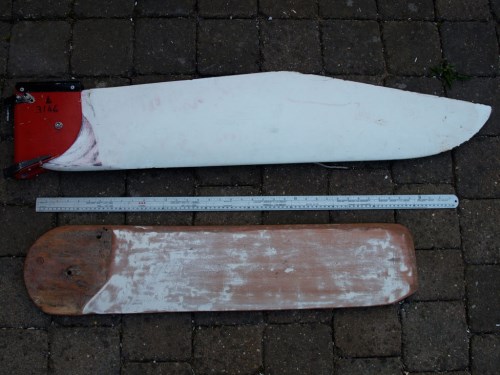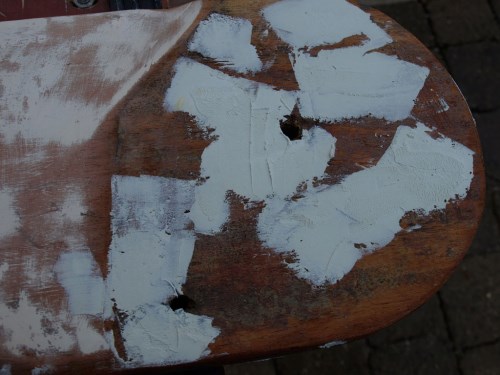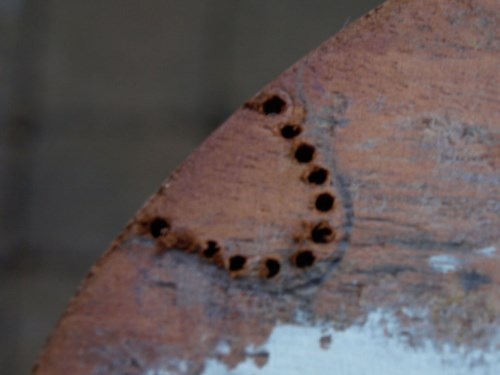Caution Water Blog
Below you will see some of our blog posts. To see any older posts, hit the "previous" link, and to see any newer posts, hit "next".
It's been too long! Life has gotten in the way, with a wedding imminent. In three weeks time, the Caution Water staff are tying the knot, yet I've still found time to buy a new boat...
A few weeks ago I purchased a Laser 4000. The Merlin got sold about a year ago (wonderful boat, but I couldn't look after it well enough, so am now looking for a GRP hull wooden deck one).
Why a Laser 4000? Well, I wanted something fast and whizzy, and it definitely fits the bill. Got it for the right price off Ebay, and after watching 2 weeks of olympic skiff sailing the mood was set. Becky hasn't sailed it with me yet (she doesn't want bruises or broken limbs before the wedding), but fortunately two people, Mya and her mom Carolyn, from down our club, were stupid/brave enough to try it with me.
We took it up to Bala for the day and took out a day membership at the sailing club there - very friendly bunch of people. This way we had a power boat keeping an eye on us in case we capsized. The wind was all over the place, but sailing a high performance tippy skiff was a lot easier than we thought (either that or we've nailed this sailing lark). When I tested it on our lake a few weeks ago, as soon as it came off the trailer it tried to fall over - but once it gets moving, it's steady as a rock. Gusty and shifty but light winds, the Laser 4k sails like a dream, and once the gennaker gets up, it just takes off.
Hopefully we'll get it up to Bala again after the wedding before the winter, but for now wedding plans take priority! Who knows, maybe we'll get a rigging guide up soon, they work well on one design boats like the 4k.
Back to Top
We've been a little busy of late, with non sailing things unfortunately (still hoping to get on with the race series soon and some more printable rigging guides), but I thought it overdue to give an update on the Merlin Rocket.
We've had Sledgehammer about 9 months now, and criminally underused it. We've had some problems publicised on here (4 ft rudder, 2 ft lake), although most of those are out of the way now (including some more I haven't mentioned yet). We have a new (reconditioned) rudder blade now, and it works perfectly. We took the boat out for it's first race in our hands back in late April. The last time we had sailed we had a soundtrack of shrieks as the boat was a little tippy, but this time, everything worked perfectly, we had a great race (still came last I think), but, we managed a race. Bec even admitted after that it was the most fun she'd had down our club for a long time. Just as well we got through a race, as the next race planned was the 5 hr race in aid of the RNLI.
Our club used to do a 24 hr race marathon, through the night, but it was stopped due to poor attendance, rocketing insurance fees and an unfriendly park/council. It was dropped to 6 hrs, and then a pirate day instead, and then this year they brought back the 5 hr race as it was the club's 40th anniversary. Bec wanted to sail her Laser, I wanted to sail the Merlin. Fortunately I found two willing volunteers as crew, one, a friendly chap by the name of Ian, who had previously briefly sailed National 12s, and Josh, one of the keen teenagers down the club, who had briefly sailed a Merlin with a friend down in Salcombe. I was quite enthused by their experience, although didn't find out until half way through their respective stints the National 12 crewing was about 30 years ago, and the sailing a Merlin in Salcombe didn't last long until they capsized. But hey ho, they were willing to give it a go.
So I went out for a pre sail with Ian a few weeks previous to the race, in very light winds, and within about 20 minutes we had the balance and communication sorted. I had half an hour with Josh the night before the race, again in light winds, but no problems working together, despite the fact I hadn't sailed with either before.
Balance and communication... for those of you who haven't sailed a Merlin Rocket before... imagine a Lark, or a Gull, about 10 times as tippy. If you've sailed skiffs, you might know what I mean - if you can keep your balance in a Merlin, you'll never have problems with balance in a boat again. Move your shoulders inwards... and the boat tips. Breathe out too fast, and you might get wet.
So let me set the scene. Our lake is tiny - about 15 acres in total, and surrounded by trees on 80% of it's banks. Our sailable area is about 8 acres. Most of the time the prevailing wind is from the South East, and runs down the lake from the deep end up towards the hall in the park. We've developed wind maps to show how the trees around the edge affect the wind, there's a few really swirly bits, but it's manageable as it's like that 80% of the time.
However, for the three weeks leading up to the race, the wind had been coming from the NW... sweeping over the top of the hall, across the lawn, but at the same time coming over the woods, and over the hill, over the side of the lake, and mixing with the other wind. Nightmare. Horrible wind shifts, at the bottom mark you can't tell what it's doing - two boats, ten feet apart, same direction, on opposite tacks (as in the hulls pointing in the same direction, but the sails on opposite sides).
I'd warned my crews that if we had a really windy day, we wouldn't sail the Merlin, we'd take the Laser 2 out instead. In light winds it sails really poorly, but in high winds its a blast, as opposed to the Merlin, which in light winds is great, and we hadn't really sailed in strong winds, and I didn't want the first time to be for five hours straight.
The morning of the race dawned. I got up, and looked out. Heavily overcast skies, and the neighbours tree (the best wind indicator I have, it's some kind of American pine), blowing about quite a bit. First thing in the morning, if we're going to have a good Force 2-3, it would be doing nothing. Blowing around as it was, that kind of said "Force 5". Ho-hum.
The kit for both boats went down the club. Again, the wind was really fickle. Strong gusts one moment, nothing the next. So, we took a vote, and decided on the Merlin. Ian was to crew for the first 2 hours (as he was on a race duty later on), and Josh for the last three. Everything was prepared, we got afloat, the rivalry between us and Becky somewhat friendly, and the race started. We didn't get off to a great start, getting to the first buoy in last place. We were being somewhat careful though - what I didn't mention, was the night before during training with Josh, I sat up on the side, and heard a "Crack!" The inwhale had split, where the joint was on the wood the glue had failed. It wasn't too bad, I thought we'd risk it.
So we raced... and didn't get very far very fast. We made up a couple of places over the next hour or so. THe wind was pretty fickle and strong, Force 3 most of the time, but it was manageable. Then, just as the first hour passed, we had a squall come through. We had eight boats racing, and three capsized at once - one, a Signet, was abandoned as their was a six year old with parent in it. At that point we just held on for dear life and sailed - survival conditions. It peaked at about Force 4-5, but we developed a 2 foot swell/wave in the middle of our lake.
For the people out there now saying "Force 5? So what!"? Remember, our lake is 15 acres, with only about 8 of that sailable (muddy creeks, shallows, fishermen, trees). Due to mainly it's size but also many elderly sailors who don't like too much wind, we rarely sail over Force 3 - it quickly gets to the point where you're whipping back and forth so quickly tacking and settling is difficult, and it's hard to make headway up a lake when you're tacking, sailing 20 metres, tacking, drifting back 5 metres during the tack... etc. So Force 5 - pretty tricky on our lake. If it was a normal race, it would have been cancelled - but we had people visiting from other clubs, so they kept it running.
Fortunately, the strong winds didn't last too long. It dropped down to about Force 3 for our changeover (5 minutes breather), then back out. My cheeky competitor, Becky, who was about three laps in front of us at this point, decided to stop, land, and sit on a bench for five minutes to eat her sandwiches (and still beat us). With Josh now crewing, we got a pretty good rhythm going again. We had a few scares (like when on a pretty deep run, with an Enterprise either side of us, one refusing to give water, I attempted to head up, got the tiller extension first caught in the string holding my hat on, and then stuck in the transom, and couldn't move), and the small crack in the inwhale gradually moving along the deck (it ended up at 6 feet long), but we didn't make up many places. The wind finally died down though, and for the last hour it was quite calm, and pleasant at about Force 2.
In the end, we came fifth out of eight. Not bad considering the five hours I spent in the boat was twice as many as I'd been in it for at that point. Positions 6, 7 and 8 were respectively, an Enterprise with novices in who had some equipment problems and were on shore for about 20 minutes of the race, a Laser which retired, and previous Signet, which retired, then was unceremoniously dumped on it's trailer off centre, punching a whole through the floor. Not a bad start for the Merlin.
Two months later, the gunwhale has been mended, a few more places reglued where it was failing, and its ready to go again. It's next outing is Bala this weekend hopefully (weather permitting) and then after that, hopefully a race series in the autumn. There may be trouble ahead...
Back to Top
I mentioned in an earlier post that the rudder for our Merlin Rocket was too long, or our lake too shallow, one of the two. The length of the rudder is the easier of the two to fix without expensive dredging equipment that the council wouldn't appreciate, so thats the direction I headed in.
The original rudder, shown below on the top, is just over 3 and a half feet long. After discussions with a friend of ours, Mike, and after scouring Ebay for second hand rudders, I decided the easiest method to solve this problem was to make a new rudder. The fancy rope/elastic/pulley downhaul system I rigged up ultimately didn't work, and on a bit of a gusty day resulted in the first unintended capsize we've had together on our lake, partly due to lack of steering, and partly due to I'm not quite sure (I dumped the mainsheet, it didn't nothing, and we still capsized).

Photo 1. New and old rudder
So, using the current blade head and our Laser 2 blade, I designed a new rudder blade template on hardboard. Two actually, one just longer than the other, both around three feet long. We have no problem with our Laser 2 rudder other than initially launching where it's about 9 inches deep, and no rudder drops down completely. I eagerly awaited our friend to price up some marine ply, which didn't happen due to him being too busy.
Instead, he did one better. He happened to drive past me one evening, called me over to the car, pointed out two rudder blades in his back seat, and asked me which one I wanted. One was a quite oddly shaped GRP one, and one looked very familiar in shape. I took it home, and checked it out. Sure enough, it was almost identical to the Merlin blade. Mike - I'll say it in writing, you're an absolute star. It's shown above in it's sanded down form, after paint removal.
It needed a few modifications. It needed a good clean and sand down first, and after two hours with a hot air paint stripper it was more or less clear of paint. It then required a sand down on the faces, and the two edges cleaning up, and the bottom edge cleaning. There was a sizeable chip taken out of the front edge at the bottom, but a bit of sandpaper treatment later you can't really tell. It's not perfect, but not bad. Quite a bit of filling then followed, to fill various dings and hollows, as shown below. More sanding followed this.

Photo 2. Rudder covered in filler
Next I needed to cut a U-shaped notch at the top - the Merlin rudder stock has a spring loaded cam in which when the blade is fully down it locks into position, instead of using a downhaul. This is great, unless you can't push the blade all the way down if you're stopped by something like, I don't know, the bottom of the lake. Rather than modify the stock by taking out the cam, it was better to modify the blade. Measured, scribed with pencil, then a series of small holes were drilled (shown in Photo 3), cut out with a hack saw, cleaned up with files, rasps and sandpaper was used to create the notch. Rudder inserted into stock in the up position (about 4mm too thin for the stock, but that's ok), and the blade unfortunately wouldn't go down. It turns out the shape of the head was a bit different after all.

Photo 3. U Shaped notch drilled
Measure. Sand. Measure. Sand. Measure. Sand. About an hour later, with about 3/8 of an inch to 1/8 of an inch removed around the head of the blade, it now all worked, fitted in the stock properly, and rotated into position, with the cam locked in place. Unfortunately, it locked in place a little too well, as the angle of the notch was a bit too extreme for it to come out again. More measuring and sanding, and eventually I got to the point where it locks into position, but a relatively light knock on the front of the blade will kick it back up, rather than stick it in the mud at the bottom of the lake, but the water pressure shouldn't be strong enough to knock it out of place. I pretty much gave up taking photos at this point as the camera was getting a bit dusty with all the sanding.
So, it's now ready for finishing. Rather than marine ply, it seems to be some sort of hardwood (god knows it blunted enough sandpaper), so I don't need to worry too much about it swelling on the approximately 2 hours of contact it may have a week with water. After discussing my options, varnish was eliminated as taking too much time, too many coats, not being hardwearing enough, and the wood finish was still partly covered in paint so it would have looked rubbish.
Gelcote was then eliminated as the gelcote I have which I thought would work is missing a waxing agent, and would take far too long anyway.
Ultimately, I've gone with a multicoat marine paint, which cost me £15. I looked at separate primers and white topcote and didn't want to spend in excess of £30 on enough paint to cover half a hull just for one rudder blade. So far it's had a brush applied base coat, and will shortly receive a gloss roller applied topcoat. I don't think that will be enough - but it's enough to seal it for a test run this weekend. When the paint is dry, two ropes need to be applied (no more nails plus a few nails, ironic eh) as an uphaul and downhaul, and if it needs more coats of paint it will get them. More photos on that later.
Did I mention after sailing now for an hour in the Merlin, I plan to do our clubs 5 hr race for the RNLI in it, in only 2 and a half weeks time? Unless it's too windy, in which case we'll jump into the Laser 2. Becky has, naturally, abandoned me and plans to sail on her own in her Laser 1 for 5 hours. I don't think I stand much chance of beating her, but I'm sure I'll pay for it if I do get lucky.
PS Sorry for the lack of updates lately. A Laser 2 rigging guide will be with you shortly.
Back to Top
View Older Posts